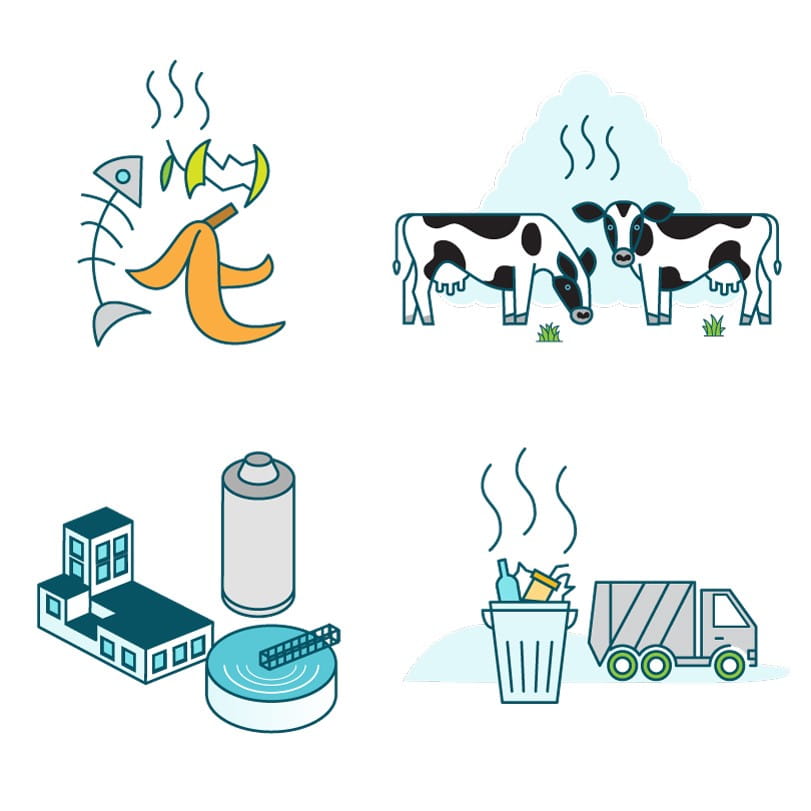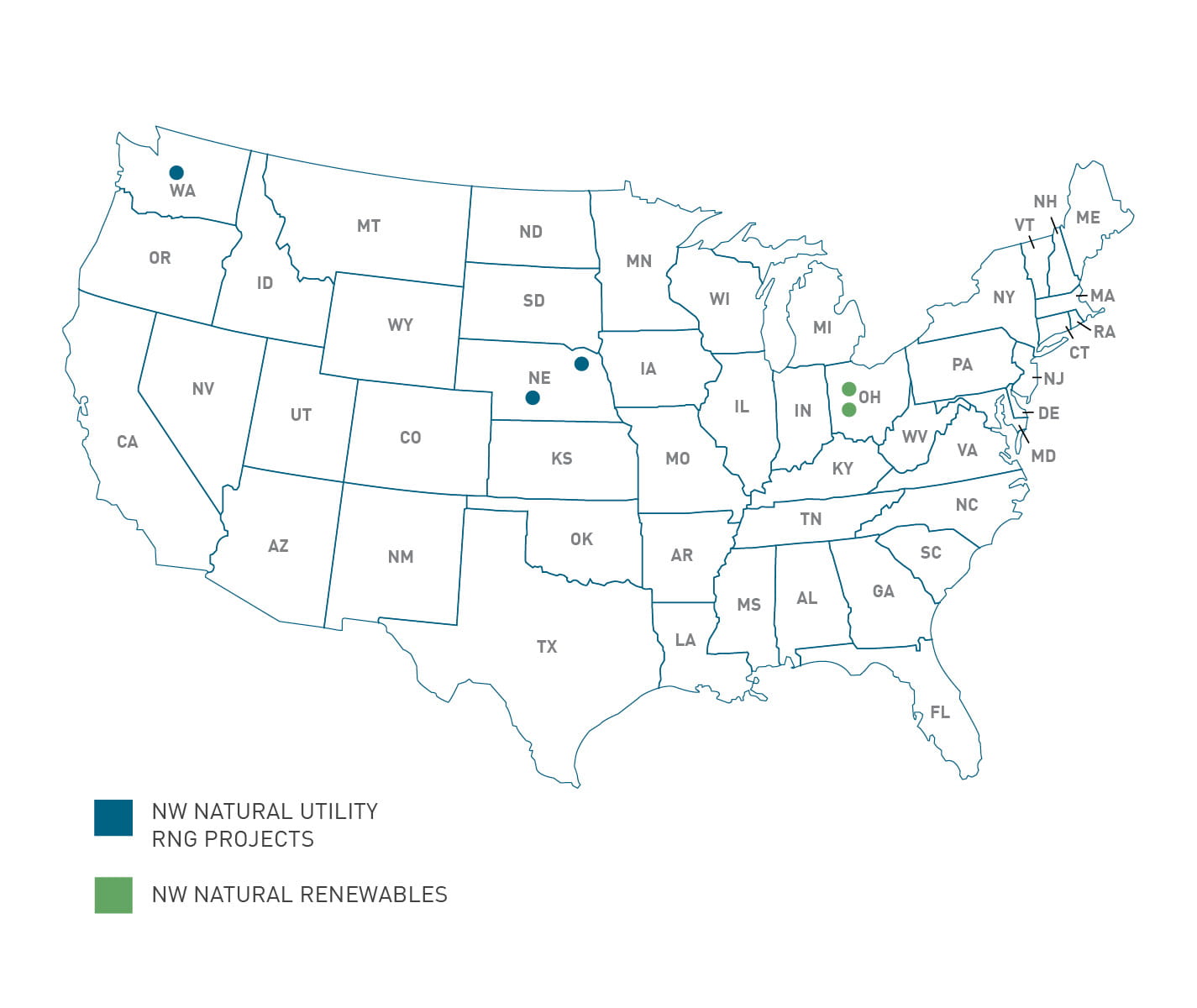Shifting from fossil fuels to renewable resources and new technologies is at the center of our goal to deliver carbon neutral energy by 2050. Do we have a lot of work ahead? Yes. We are at the beginning stages of developing renewables for the gas system.
As our nation’s electric system continues to work to increase wind and solar generation from 14% annually[1]U.S. Energy Information Administration, “Electricity Explained” Available at: https://www.eia.gov/energyexplained/electricity/electricity-in-the-us.php, we also need to aggressively accelerate development of renewables for our pipeline networks.
A diverse energy system – with renewable electrons delivered over wires and renewable molecules delivered underground provides a hedge against potential reliability risks while supporting shared climate goals.
What is renewable natural gas?
Renewable natural gas (RNG) is not a fossil fuel and does not add more carbon dioxide into the atmosphere. RNG is derived from biogas, which is produced from decomposing organic waste from landfills, agricultural waste and wastewater from treatment facilities, that has been captured and cleaned for the pipeline.[2]EPA, “An Overview of Renewable Natural Gas from Biogas,” 2021, available at: https://www.epa.gov/sites/default/files/2021-02/documents/lmop_rng_document.pdf
Our renewable natural gas projects
Today our system is making it possible for the first RNG projects in our region to deliver their low-carbon fuel, primarily for the transportation sector. We’ve also started delivering small volumes of RNG to our customers. We have a team focused exclusively on securing supplies of RNG for our customers. It’s an important step on our journey to transition our business, but there’s far more to do and we’re going to need policy support to get there.Agricultural Waste
Tyson Foods: Our first investment under SB 98 supported the development of a biogas facility that is now operational and converting methane from a Tyson Foods processing plant into RNG. In December 2021, NW Natural initiated investment in a second development project with Tyson Foods and construction of the biogas facility is currently underway.
Shell New Energies: The Shell New Energies Junction City facility in Oregon uses locally sourced cow manure and excess agricultural residues to produce RNG. It began sending RNG through NW Natural pipelines in December 2021. The facility supports the local economy and helps farmers manage agricultural waste, reduce expenses and protect local air and water quality.
Wastewater
MWMC: In November 2021, the Metropolitan Wastewater Management Commission's treatment plant in Eugene became the first public agency in Oregon to produce RNG. Nearly all of the biogas from the facility’s anaerobic digesters that stabilize and treat solids is “scrubbed” and then injected into NW Natural's system. RNG also provides the MWMC with potential for an additional revenue source, by selling the gas and its renewable fuel credits to an off-taker that will use it for fueling vehicles.
Element Markets: Through agreements with Element Markets, Archaea Energy and BP Products North America, NW Natural is purchasing the environmental attributes, or Renewable Thermal Certificates (RTCs), generated by a new RNG facility at a wastewater treatment plant in New York City and a Wisconsin-based mixed waste anaerobic digester facility.
Senate Bill 98
Find out about the groundbreaking Oregon legislation that makes this progress possible.
SB 98 details
2024 RNG Request for Proposal
RFP details
Answers to customer questions about RNG
Is RNG in use today?
RNG is already in use at major facilities like WM (formerly Waste Management) and the Seattle-Tacoma (SEA) Airport, which is helping the Port of Seattle halve its GHG emissions by using RNG to heat the airport and power the Port’s bus fleet. As of November 2023, there are 800 RNG facilities online, under construction or being planned in the U.S. today[3]The RNG Coalition, available at:https://www.rngcoalition.com/infographic. In Europe, RNG is part of a multi-solution approach to achieving climate goals and increasing energy independence. Denmark is a great example. Country-wide development in turning organic waste streams into a climate solution has allowed Denmark to achieve close to 40% of its total gas use in homes and businesses as RNG, with a goal of completely displacing fossil fuel use by 2030[4]Bioenergy Insight, Biogas takes up 40% of methane in Denmark’s natural gas grid, 2022, available at: https://www.bioenergy-news.com/news/biogas-takes-up-40-of-methane-in-denmarks-natural-gas-grid/.
Is there enough RNG?
Studies indicate that the potential supply of RNG is vast. An Oregon Department of Energy report identified nearly 50 billion cubic feet of technical potential, equivalent to the total amount of natural gas used by all Oregon residential customers today. Nationwide, RNG production potential is estimated to be 10 to 30 times greater than current production, and development is accelerating as spurred by state carbon policies and the federal Inflation Reduction Act (IRA).
What role does RNG play in the clean energy transition?
According to the RNG Coalition, the scope of the organic waste problem is huge. The World Bank projects the total volume of solid waste to grow 69% by 2050[5]. According to the International Energy Agency, the organic feedstocks that can be used to produce sustainable RNG will grow 40% by 2040[6].
In the U.S., EPA estimates decomposing waste accounts for about a quarter of America’s methane emissions. That’s roughly the same amount of methane emissions associated with both the oil and natural gas production sectors combined[7]EPA; U.S. Methane Emissions, By Source; all emission estimates from the Inventory of U.S. Greenhouse Gas Emissions and Sinks: 1990–2021,available at: https://www.epa.gov/ghgemissions/overview-greenhouse-gases#methane. There are vast opportunities to take organic waste, clean it to pipeline quality and displace conventional natural gas on our system – for substantial carbon savings[8]An American Gas Foundation Study Prepared by ICF, Renewable Sources of Natural Gas: Supply and Emissions Reduction Assessment, December 2019, available at: https://gasfoundation.org/2019/12/18/renewable-sources-of-natural-gas/.

